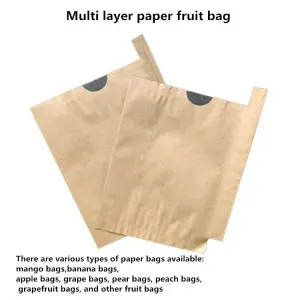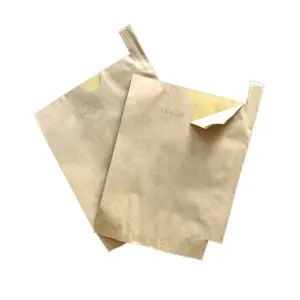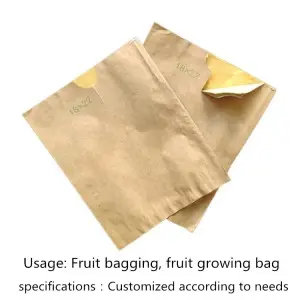Oct . 11, 2025 10:35 Back to list
Eco-Friendly Fruit Paper Bags | Breathable, Food-Safe
fruit paper bags: field notes, specs, and what growers really ask
On paper (pun intended), the product name “FRUIT BAGGING, INSECT PROOF, WATERPROOF, AND BIRD PROOF” sounds utilitarian. In the orchard, it’s a quiet revolution. I’ve walked rows in Zhao county, Hebei, where growers insist these fruit paper bags cut sprays, keep birds guessing, and ship a cleaner, glossier crop. That’s not marketing fluff—just practical outcomes when you bag at the right stage and use the right spec.

Industry trend check
Global orchard managers—apples, pears, mango, pomegranate, even grape clusters—are shifting to fruit paper bags to reduce pesticide residues, meet retailer MRL targets, and limit pecking damage. To be honest, it’s partly compliance, partly brand image. And it works: many customers say they trimmed 1–2 sprays and saw fewer cosmetic defects.

Typical specs (real orchards, not lab benches)
| Parameter | Spec (≈, real-world may vary) | Standard/Test |
|---|---|---|
| Base paper grammage | 60–100 g/m² | ISO 536 |
| Water resistance (Cobb60) | ≤ 25 g/m² | ISO 535 |
| Tensile strength (MD/CD) | ≥ 4.5/2.5 kN/m | ISO 1924-2 |
| Bursting strength | ≥ 250 kPa | ISO 2758 |
| Coating | Wax/PE-like barrier 6–12 g/m² | Internal QC |
| Food contact | GB 4806.8 / FDA 21 CFR 176.170 | Migration tests |
Origin matters: these are produced in Caozhuang Development Zone, Fanzhuang Town, Zhao county, Shijiazhuang, Hebei—close to vast apple and pear belts, which frankly speeds feedback loops.

How they’re made (and why that matters)
- Material: FSC pulp base paper; optional inner wax or biodegradable barrier; water-based inks.
- Method: sheet forming → barrier coating → flexo printing → die-cut → gusset/bottom glue → tie-wire or string.
- Testing: grammage (ISO 536), Cobb (ISO 535), tensile (ISO 1924-2), burst (ISO 2758), moisture (ISO 187), food-contact per GB 31604 series.
- Service life: one growing season (≈60–120 days on tree); shelf life ≈24 months below 30°C, 65% RH.
- Industries: conventional and organic orchards; export packers; trial plots; university extension farms.
Vendor snapshot (what buyers usually compare)
| Vendor | Lead Time | Certs | MOQ | Notes |
|---|---|---|---|---|
| Hebei Producer (JML) | 15–25 days | ISO 9001, FSC CoC | ≈ 30,000 pcs | Strong barrier control; orchard-grade QC. |
| Local Converter B | 7–10 days | Basic QC | ≈ 5,000 pcs | Fast but variable Cobb values. |
| Importer A (EU/US) | 30–45 days | FSC, Food-contact docs | ≈ 50,000 pcs | Stable, pricier; strong documentation. |

Applications, customization, and small but crucial choices
Use fruit paper bags at fruitlet stage post-thinning, dry weather preferably. Options that matter:
- Sizes: single-fruit (apple/pear), cluster (grape), large (mango/pomegranate).
- Perforation: micro-vents for humidity control; anti-fog windows for inspection.
- Color: brown/black for sunburn protection; white for reflectance and finish.
- Printing: water-based logos, harvest instructions, QR traceability.
Case results (two orchards, different climates)
Zhao county apples: internal trials showed Cobb60 ≈ 22 g/m²; field notes recorded 28–35% fewer insect blemishes and ≈70% drop in bird peck marks over 90 days, compared with unbagged rows. A coastal mango grower reported 1 fungicide pass removed and smoother blush—shipment claims fell “noticeably,” their words, not mine. Of course, weather swings can nudge outcomes.

Compliance and paperwork (because buyers ask)
Expect ISO 9001 process control; FSC for pulp chain-of-custody; food-contact declarations referencing GB 4806.8 and FDA 21 CFR 176.170; migration tests per GB/T 31604 and EU 1935/2004 frameworks. If you’re organic, request an ink/coating statement plus allergen-free letter.
Bottom line
The right fruit paper bags are boring in the best way: they just work. Pick a credible barrier, size it properly, and keep a few micro-vented SKUs for humid spells. You’ll likely ship a cleaner, more market-ready crop—and that’s the whole point.
- ISO 536: Paper and board — Determination of grammage. https://www.iso.org/standard/7575.html
- ISO 535: Paper and board — Determination of water absorptiveness (Cobb method). https://www.iso.org/standard/54158.html
- ISO 1924-2: Tensile properties of paper. https://www.iso.org/standard/35866.html
- FDA 21 CFR 176.170 — Components of paper in contact with aqueous and fatty foods. https://www.ecfr.gov/
- GB 4806.8-2016 — Food contact paper and paperboard (China). http://openstd.samr.gov.cn/
- Regulation (EC) No 1935/2004 — Materials intended to come into contact with food. https://eur-lex.europa.eu/
-
Comprehensive Guide to CE Certification Apricot Pollen Health Benefits
NewsNov.24,2025
-
CE Certification Mango Fruit Protection Bags: Enhancing Export Quality & Sustainability
NewsNov.23,2025
-
CE Certification Varieties Suitable for Collecting Apple Pollen – Ensuring Quality & Compliance in Apple Breeding
NewsNov.22,2025
-
Comprehensive Guide to CE Certification Mango Cover Bags – Quality, Standards & Trends
NewsNov.22,2025
-
What You Need to Know About CE Certification Peach Blossom Powder Keto
NewsNov.21,2025
-
CE Certification Pear Pollen Collection Base – Ensuring Quality & Sustainability in Global Horticulture
NewsNov.20,2025